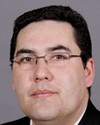Thank you. It's a real honour to be invited here to offer my input on this issue, and I'll just jump right into things.
Since disabilities are non-discriminatory, and physical, mental, emotional, or sensory disabilities can be acquired at any time to anyone regardless of age, race, education, or social or economic background, I think we all have a stake at looking at the employability of persons with disabilities today.
As you know by now, some disabilities are temporary in nature, some are permanent, and some are easily accommodated, while others are more of a challenge. The fact is that eventually the likelihood is that most of us will have a disability at one point or another in our lives. I think the numbers have already been discussed by a number of the other witnesses before me, so I won't go into any detail about the statistics.
Before continuing, I want to tell you a little bit about my own background. I have more than 15 years of experience working with people with disabilities of all types, in both front line and management capacities. In my current work as a consultant on employment and disability issues, my goal is to make it easier for people with disabilities looking for employment and employers to connect.
Why would the federal government care about this issue? Because, as I believe and a number of other witnesses have explained, the workforce shortages will require Canadian employers from all sectors, including public, private, and non-profit, to access and use all available talent pools for human resources. Immigration alone will not solve our workforce shortages, and increasing the retirement age will also mean that employers need to better understand accommodation issues that arise as we age.
For the purposes of this presentation, employability will mean any of the following: part-time, full-time, temporary, permanent, or seasonal employment; short- or long-term contracts; self-employment; supported employment opportunities; or student summer job placements.
First, employability for people with disabilities is not just about doing the job--although obviously it's the most important, and a factor of employability--but it's also about being able to get to that job, having access to employment-related training opportunities, access to supports that facilitate finding and maintaining employment and supports, such as attended care for people with some physical disabilities. It's also about timely and appropriate provision of technical aids, access to education, and access to career development practitioners, including job developers who understand disability issues. These career development practitioners are in both private and non-profit service agencies as well as in college and university career centres.
Other issues that affect employability include the lack of harmonization of legislation across federal and provincial boundaries or departments. Employability is also about supporting the needs of immigrant and visible minorities with disabilities, aboriginals, injured workers on return-to-work programs, students with disabilities, etc.
It's a pretty complicated situation, but I don't think it should be. I think the issue is that people want to work so let's help them. Most people want to contribute, and most employers really want access to the best talent available. A talent pool of people with disabilities has some of that depth. But it means that we have to work together to make it happen.
What can we do to make sure that all people who are able to work can find employment? Since most solutions to workforce shortages are predicated on a combination of immigration and increasing numbers of older workers, there are a couple of things that I think need to be addressed.
One is that while not all immigrants, by any stretch of the imagination, have experienced war or civil strife, many of those who have may have mental health problems that surface only once they are feeling comfortable in their new life. These mental health issues will need recognizing, addressing, and programs to deal with them effectively so that the person is able to continue on with minimal disruption to their work experience. The federal government could work with other stakeholders to ensure that appropriate programs are available regardless of where that individual moves in the country.
There also seems to be little discussion on how to accommodate the growing needs of older workers, although I recognize that a task force was recently struck to deal with that issue. While increasing the retirement age does seem to offer solutions, it isn't without some problems. The main problem is that as we get older, we're at greater risk of developing disability and chronic medical conditions, mobility issues, and sensory disabilities. Strategies, again, will need to be developed to accommodate those needs. I believe the federal government can play a role in convening various stakeholders--all stakeholders hopefully--to ensure that a comprehensive strategy is in place.
Another thing the federal government could do is lead by example, as one of the biggest employers in Canada, if not the biggest. The private and non-profit sectors also need to see that you, as a national government, value the abilities of people with disabilities. If you're not able to increase the representation of people with disabilities in your workforce, that sends a very strong negative message to other employer groups.
That being said, there are many employers that have seen the value and that are actively recruiting and employing people with disabilities. Some of them are big business, like banks, but there are a number of other smaller employers hiring people with disabilities as well, because they recognize the value that those people's talents bring to their business.
The federal government could help the cause by developing a national recognition program to honour the employers of various sizes that are employing people with disabilities, much like NRCan is doing.
Typically, business people like to learn from other business people. Perhaps the government could partner with umbrella groups like the Canadian Chamber of Commerce, the Canadian Federation of Independent Business, and the Canadian Labour Congress to develop the business case and a communications strategy for getting the work out.
There are also return-to-work programs for people with mental health issues. The Global Business and Economic Roundtable on Addiction and Mental Health has a report that outlines steps to minimize the impact of mental health on the workforce.
Also, early intervention programs need to be put in place to recognize things like learning disabilities at an early age and to implement strategies for minimizing the impact on a person's employability.
Last, there's a need to get involved in the inmate population and to recognize the invisible disabilities that are prevalent among inmates and people with criminal backgrounds, and to develop a strategy to help those people increase their employability and decrease their recidivism rate.
Thank you.











